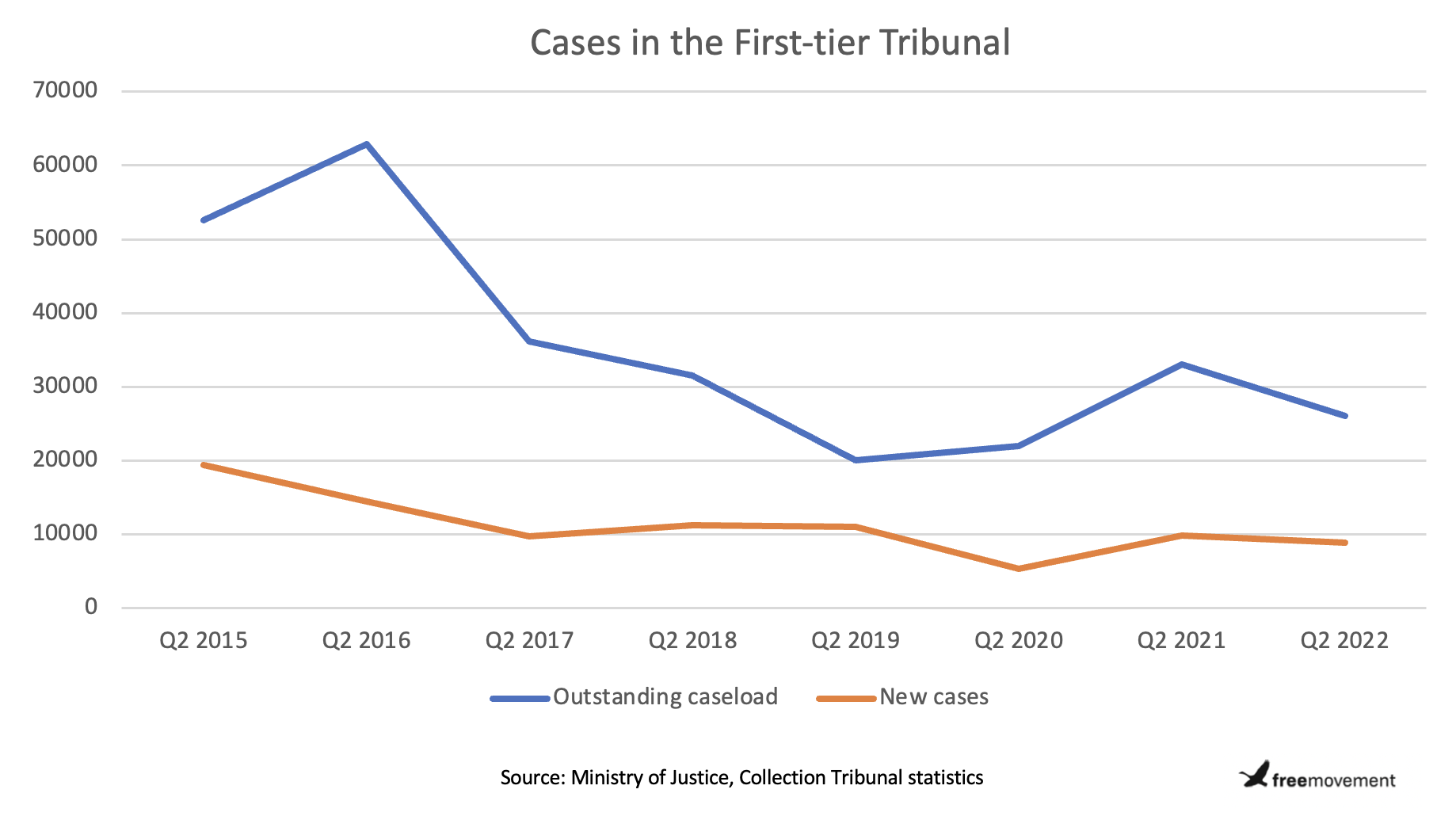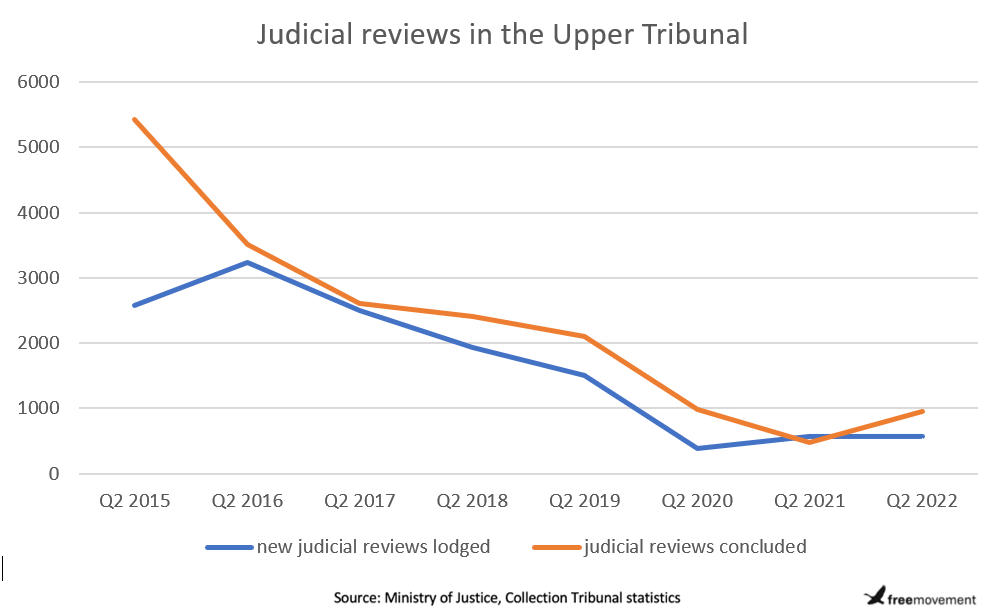- BY Josie Laidman

Tribunal quarterly statistics: 54 week waiting time for asylum appeals and 26,000 cases outstanding
THANKS FOR READING
Older content is locked

A great deal of time and effort goes into producing the information on Free Movement, become a member of Free Movement to get unlimited access to all articles, and much, much more
TAKE FREE MOVEMENT FURTHER
By becoming a member of Free Movement, you not only support the hard-work that goes into maintaining the website, but get access to premium features;
- Single login for personal use
- FREE downloads of Free Movement ebooks
- Access to all Free Movement blog content
- Access to all our online training materials
- Access to our busy forums
- Downloadable CPD certificates
The tribunal quarterly statistics for the period July to September 2022 show that waiting times for appeals have increased, but the number of new cases entering the tribunals continues to decrease. The number of cases being decided has also increased.
The statistics show that the average time to clear all types of appeals in the First-tier tribunal is 41 weeks. There is a 54-week waiting time for asylum appeals. Waiting times were around six months for asylum appeals before the pandemic, so the increase is significant. But this is still incomparable to the current waiting times for asylum decisions in the Home Office, which have become a matter of years. You can read more about the Home Office’s quarterly statistics and their effect here.
Human rights appeals have an average waiting time of 51 weeks. And EEA free movement/EU Settlement Scheme appeals are taking 37 weeks. There is a worrying average waiting time of 39 weeks for appeals from individuals in immigration detention to be decided.
The number of detained immigration appeals and foreign national offender deportation appeals remain almost equally as low as during the pandemic. This quarter there were 21 appeals and 156 deportation receipts in the First-tier Tribunal. In the same quarter in 2018/19, before the pandemic, there were 124 appeals and 533 deportation receipts in the First-tier Tribunal, as well as 131 deportation receipts in the Upper Tribunal.
Yesterday’s press release that confirmed there would be a five million pound investment to increase the number of days the tribunals operated, in a bid to decide up to 9,000 more cases before the end of March 2023. The average waiting time is of course not satisfactory, but the statistics do show the tremendous effort the tribunals have gone through to clear the backlog already. Between July and September 2022, the outstanding caseload in the First-tier Tribunal has already decreased by 23%, to 26,000. The outstanding caseload in the same quarter of 2019 was 20,000, but it had risen to 33,000 by 2021.
In addition to the backlog of cases beginning to be cleared, the number of cases received this quarter has dropped by 11%, to 8,900 compared to the same period last year. The major long term trend here is that the number of immigration appeals being lodged has basically halved over the last decade.

The proportion of types of appeals being heard in the tribunals is roughly the same as in 2019, with the exception of the number of EEA/EU Settlement Scheme cases. They have been increasing steadily since the route closed in June 2021 and they now make up 43% of all cases the First-tier Tribunal has received. However, the number of new cases this quarter has dropped by 14%, to 3,900 compared to the same period last year.
This quarter, 72% (6,600) of cases were determined by a judge at a hearing or on the papers, compared to 52% of cases in the same period last year (with the rest being withdrawn, not served, or the like). Of the 6,600 cases determined by a judge, 49% of asylum and protection cases, 53% of human rights cases, and 48% of EEA appeals were allowed/granted.
In general, the statistics do not currently include figures for the Upper Tribunal because that tribunal is being migrated to a new case management system and the data has not yet been quality assured. The statistics do show that more cases are being decided (960) than new judicial review proceedings are issued (570). However, the number of new proceedings and cases outstanding are increasing by 14% and 18% respectively, compared to the same period last year.
Of the 960 judicial reviews that were considered in the Upper Tribunal, 47% were determined, 2% were transferred to the Administrative Court, and 51% were either withdrawn or not served. 290 judicial review applications were determined by paper hearings, of which only 18% were allowed to continue to a substantive hearing. 35 cases were reconsidered at an oral renewal, of which 94% were allowed to continue to a substantive hearing. During this quarter, there were 12 substantive hearings, of which 33% were granted in favour of the appellant.
There were 570 new judicial review cases lodged this quarter. The same number were lodged in the same period last year, however only 480 were considered in the same time frame. In general, the number of judicial reviews lodged have been decreasing over time, despite the number of comments from the government about excessive legal challenges.

Waiting times for appeals have almost doubled since the pandemic and there is still work to reduce this again. The government’s investment might be welcomed to assist with the backlog, but what the additional operating timetable will look like needs to be carefully considered in light of some of the failures and complaints over the criminal courts increasing their operating days previously. In general, the tribunals seem to be continuing to recover from the pandemic and reduce their caseload much more effectively than the Home Office. As we move further from the EU Settlement Scheme deadline of 30 June 2021, we should also see these cases appear in the tribunals less frequently, leaving more room to reduce waiting times for other appeals.
